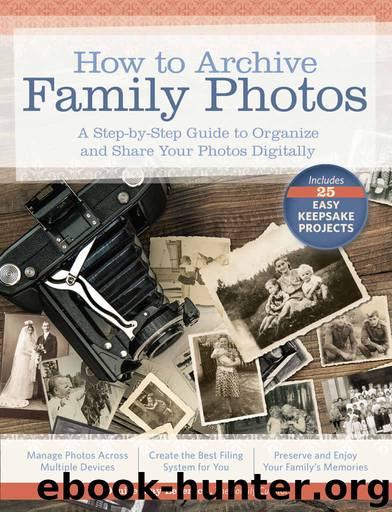How to Archive Family Photos by Levenick Denise May

Author:Levenick, Denise May
Language: eng
Format: epub
Publisher: F+W Media
Published: 2015-04-24T00:00:00+00:00
DIGITAL SCANNER TERMINOLOGY
When you first start looking for a scanner, the scanning jargon may sound like a foreign language. Here are some key scanning terms and features you should know.
Auto file naming: Save time by using your scanner’s file-naming features. This is usually available through the scanner’s Preview window as an option for you to enter a custom name and a starting number. It uses the custom name you provide and automatically adds unique sequential numbers to each image.
Batch scanning: This feature lets you scan multiple photos in one pass of the scanner. Some scanners will automatically detect each item; other scanners require manual selection. Each photo is saved and named individually. This feature saves time when scanning large collections.
Color: Scanners typically offer 8-bit or 16-bit grayscale (aka black-and-white) or 24-bit or 48-bit color options for scanning. Color is the best choice for digitizing all photographs, whether the originals are black-and-white or color. The 24-bit color will give you a full range of photo-realistic color on your scanned images.
Color restoration: This feature restores faded color to old snapshots.
Cropping: Cropping allows you to cut out unwanted parts of an image. Some scanners will allow you to preview the image and crop the photo before you scan it, so you get only the photo (not the scanner background) in your scan. Portable devices typically scan the full scanning bed without a cropping option.
Descreening: This eliminates the tiny dots used in the printing process and improves scans of newspaper and magazine photographs.
Digital ICE: Use digital image correction and enhancement (ICE) to remove dust and scratches when dust removal is not sufficient. Digital ICE requires a longer scanning time and higher computer resources, but it gives a higher-quality result. Results are not visible when you preview the image. Digital ICE may not be available for all document types.
Dust removal: This option automatically removes dust on the original item; the effects are not visible when you preview the image. You may need to select the level of correction: low, medium, or high. Dust removal may not be available if digital ICE is selected, and scanning time will be longer.
File format: Most scanners scan documents and photos in many file formats. TIFF is the best choice for archival images, but it creates large image files. Most digital cameras and portable devices offer only JPG images, which is more efficient for files saved to removable storage such as an SD card or flash drive.
Max scanning size: Popular office scanners accommodate letter and legal size paper; some models can handle items up to 11x17 inches and larger. Portable devices may be limited in scanning image size. Cameras can digitize items of any size and shape.
Negatives/film/slides: A special film carrier for scanning film and negatives allows the scanner light to pass through the transparency. Software can convert the negative image to a positive image with far greater detail than is available by scanning a printed image. Not all scanners have this feature.
Resolution: Resolution is measured in dots per inch (dpi) or pixels per inch (ppi).
Download
This site does not store any files on its server. We only index and link to content provided by other sites. Please contact the content providers to delete copyright contents if any and email us, we'll remove relevant links or contents immediately.
Audition by Ryu Murakami(4100)
The Body: A Guide for Occupants by Bill Bryson(3803)
Adulting by Kelly Williams Brown(3674)
Housekeeping by Marilynne Robinson(3404)
Zero Waste Home by Bea Johnson(3294)
Be in a Treehouse by Pete Nelson(3216)
Seriously... I'm Kidding by Ellen DeGeneres(3101)
Better Homes and Gardens New Cookbook by Better Homes & Gardens(2956)
Barkskins by Annie Proulx(2881)
The Healing Self by Deepak Chopra(2797)
Hedgerow by John Wright(2779)
The Life-Changing Magic Of Tidying Up- The Japanese Art Of Decluttering And Organizing (v5.0) by Marie Kondo(2747)
Spark Joy by Marie Kondo(2680)
The Genius of Japanese Carpentry by Azby Brown(2610)
The Cellar by Natasha Preston(2596)
Work Clean by Dan Charnas(2563)
120 Days of Sodom by Marquis de Sade(2441)
The Book of Numbers by Peter Bentley(2406)
A Monk's Guide to a Clean House and Mind by Shoukei Matsumoto(2406)
